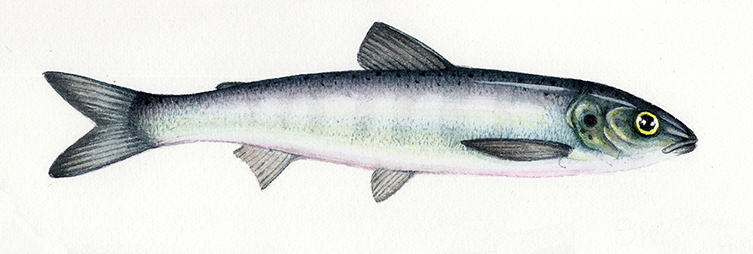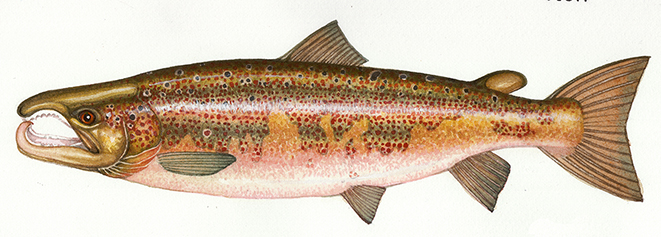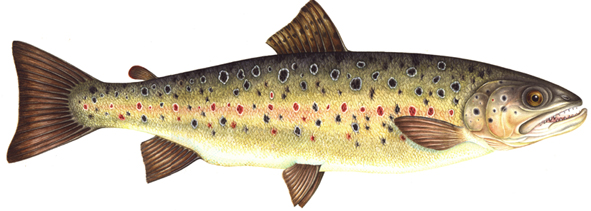Natural History Illustration: Salmon life cycle

Scientific illustration and wildlife art have been combined in a recent job; to illustrate wildlife of the River Wye for a keen local fisherman. A main focus has been the life cycle of the Atlantic Salmon, Salmo salar. In researching these fish I’ve learnt a little of the key features present in each life cycle stage.
A key resource has been the Atlantic Salmon Trust, where both visual and written references are readily available.
Salmon Parr
Salmon emerge from eggs in freshwater rivers, such as the Wye. Until they absorb their egg sacs their known as alveolin. After, they’re called fry. If they escape predation and grow to about 2inches long, they are called Parr. Sometimes they’re called or Fingerlings.

Salmon parr
A Salmon parr needs to escape predation. So it develops camaflauging “parr marks” (bands of colour) across their backs. These break up their shape and help the fish avoid being eaten by heron, mink, goosander, and other fish such as trout.
There is often confusion within the angling community when it comes to distinguishing between Salmon and Brown Trout (Salmo trutta) as the two species closely resemble each other. With the young Parr, the main differences are that the salmon has a more streamlined shape, a deeper fork to its tail, a longer pectoral fin, a sharper snout and smaller mouth than a young Trout, and has no orange on the adipose fin (at the rear, to the back)
A Salmon Parr will only sport a couple of spots on its gill cover (often just one large spot), and its parr or fingerling markings are quite crisply defined.
Salmon smolt
After a couple of years of living in freshwater, the young salmon undergoes some major alterations to its body and chemistry which enable it to migrate to the salty waters of the Atlantic Ocean where the fish will feed amd grow. These changes are called “smoltification” and occur in esturine waters where the young fish gather in shoals before setting out to the open sea.
Visually, the change from a Parr to a Smolt is primarily a loss of the stripes seen on a parr, and a change of colour as the fish becomes silvery. This is caused by guanine crystals which form a layer in the skin and obscure the spots and fingerling markings (although these are still visible on the gill covers).

Salmon smolt
Their bodies elongate and their fins darken. The silvery scales can be rubbed off easily. It’s hard to distinguish between the sexes until the males became ready to breed.
Adult salmon
As adults, the Salmon will return to the freshwater of their birth to breed. When they first appear, as “Fresh Run Salmon” both sexes are bright silver and pretty similar, with easily detachable scales. You can often tell how long an adult salmon has been in fresh water by the birghtness of its silver colouring, and from the sea lice which die when their hosts switch from salty to fresh water. A silvery adult with near complete sea lice in situ will have only just left the marine environment; one with less of a gleam and more degraded (or without) sea lice is likely to have been back in the river for longer.
Hen Salmon
The adult female fish will retain more of this silver colour than the male, although being in fresh water will cause her scales to darken, and she will develop a tiny kype or bump on her lower jaw.

Fresh run Hen Salmon
A female adult salmon is known as a Hen, a male is known as a Cock.
Cock salmon
Once in breeding colours it’s easy to recognise a Cock salmon. The two main features are the change in colour and of the lower jaw. A breeding male’s colouration is often described as a tartan pattern, and means the fish is patchy with different shades of oranges, silver, and red markings. Overall the fish is brownish-orange, pinkish-red, or yellowish in colour. There’s plenty of variation between individuals. The lower jaw develops a prominent hook or “kype” which is used to fight rivals who threated its teritory. It also makes eating almost impossible; adult salmon mostly die after mating.

Cock salmon with kype
The Cock salmon will also have an enlarged adipose fin.
Salmon vs Trout
Again, there’s occasional confusion between an adult salmon and a large adult brown trout. The Salmon have a more streamlined shape, a concave tail with a thinner neck than the trout tail, far fewer (or no) black spots below the lateral line (about half way down the fish body), and its upper jaw tends not to reach any further back than the rear of the eye. Obviously, wiht an adult cock salmon with kype and tartan pattern, the difference us clear and immediate.

Adult Brown trout Salmo trutta
One more stage in the life cycle of a salmon is that on the kelt (not illustrated). Kelts are salmon which have spawned but still remain in the river. They regain a more silvery colour but are noticably thin, with a distended vent and frequently have red “maggots” on their gills.
A hen salmon will use her tail to scrape a nest or “redd” in the pebbles and lay eggs which are fertilized by the male, cover them over, deposit more eggs on top, cover them, and so on. In time these will hatch into tiny salmon fry and so the cycle begins again.
For more information, please check out the Cornwall Rivers website, or teh Atlantic Salmon Trust. For more on this project, look at my blog on the Glanwye project.


All other on-line references I have found for MALE and female salmon call the male a BUCK and the female a hen. I accept that “cock and hen” makes more sense than “buck and hen”, but where did you get “cock” from.
I am contacting other sites asking where they got “buck” from.
Hello Keef
Its a good question! I think you’re right, they do tend to be called Bucks. I got the terminology of a Cock salmon from https://atlanticsalmontrust.org/, and there are various other references out there. I also think the person who commissioned the work, a member of the https://www.wyeuskfoundation.org/ referred to the males as “Cocks”. But I think it’s a less common term than “Buck”
Stick on the safe side and refer to male salmon as Bucks and youll be fine!
Yours
Lizzie